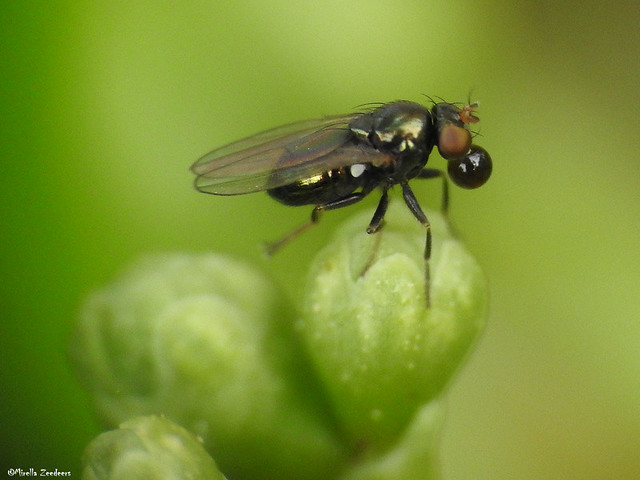
The first time I saw a fly with a droplet of water protruding from it’s mouth (or the tip of the proboscis) I was quite surprised. Why would a fly be blowing bubbles like this?

It turns out that flies do this to cool down! They move a droplet of fluid in and out and of their buccopharyngeal cavity a number of times before eventually swallowing it (Gomes et al., 2018). This is called bubbling behaviour, which helps them lower their body temperature by evaporative cooling.

Fully gorged flies eliminate excess water by bubbling behaviour. The evaporation of water concentrates the suspended nutrients and thereby reduces the crop volume, allowing the fly to resume fluid feeding, or minimize the water load while foraging for other resources (Hendrichs et al., 1992)..

As the droplet is extruded, evaporation lowers the fluid´s temperature, which, upon its re-ingestion, lowers the blowfly’s body temperature (Gomes et al., 2018).

Flies rarely move whilst bubbling, but if disturbed, they quickly reingest the liquid – although a few dropped their bubbles – and move off! (Stoffolano et al., 2008).

Some Hymenoptera (bees and wasps) also reportedly engage in bubbling behaviour, and occasionally deposit the regurgitate on the substrate, followed by subsequent re‐ingestion.

The droplet fluid consists of a mixture of liquids from the ingested food, enzymes from the salivary glands etc., with evidence pointing to a role in liquid meal dehydration (Gomes et al., 2018).

References
Coronado-Gonzalez, P. A., Vijaysegaran, S., & Robinson, A. S. (2008). Functional morphology of the mouthparts of the adult Mediterranean fruit fly, Ceratitis capitata. Journal of Insect Science, 8(1).
Gomes, G., Köberle, R., Von Zuben, C. J., & Andrade, D. V. (2018). Droplet bubbling evaporatively cools a blowfly. Scientific reports, 8(1), 1-7.
Hendrichs, J., Cooley, S. S., & Prokopy, R. J. (1992). Post‐feeding bubbling behaviour in fluid‐feeding Diptera: concentration of crop contents by oral evaporation of excess water. Physiological entomology, 17(2), 153-161.
Stoffolano Jr, J. G., Acaron, A., & Conway, M. (2008). “Bubbling” or droplet regurgitation in both sexes of adult Phormia regina (Diptera: Calliphoridae) fed various concentrations of sugar and protein solutions. Annals of the Entomological Society of America, 101(5), 964-970.
Links and blogs on fly bubbling
https://phys.org/news/2018-04-tiny-cool.html
https://www.scimex.org/newsfeed/blow-flies-blow-spit-bubbles-and-drink-them-to-keep-cool
https://www.diptera.info/forum/viewthread.php?forum_id=16&thread_id=1016
https://scribol.com/environment/animals-environment/flies-blowing-bubbles/
https://naturebackin.com/2020/04/30/backyard-curiosities-1-bubble-blowing-flies/
Very interesting; I’ve wondered about this!
How great to read this all. I had so many doubts about this behaviour after seeing it a few times, but when I also saw a black bubble I didn’t know what to think anymore! Thank you.
How great to read, after seeing it a few times I had doubts over this behaviour, especially when I saw a black bubble. Thank you!
I wonder what the fly had been imbibing that made its bubble black?!
Yes, would be interesting to know 🙂

Late comment but a question. Do all species of flies show such behaviour? This is the first time I have seen flies blowing bubbles out of their mouth. Do they do it when they are in stationary position or when they ensure that their surroundings are clear of any sight of predators or us humans?
Not sure if they all do it, there are over 150,000 efly species!😊 it will depend on the environment and circumstances. They probably do need to find somewhere safe and quiet to blow their bubbles. It is actually quite difficult to notice unless you look very carefully, or take a photo with a macro lens. But I am fairly sure it is quite common. Ray
Ah i see. So we are not able to see them blowing bubbles clearly without the aid of macro lens. Alright thanks for the answer Ray!
[…] It turns out that external nectar concentrating behaviour – where bees regurgitate a drop of nectar and then manipulate it with their mouthparts to evaporate off excess liquid – is quite a widespread phenomenon amongst all kinds of different solitary and social bees (Portman et al., 2021). As is bubbling, or bubble blowing in insects in general, as I described in a previous blog about flies blowing bubbles. […]